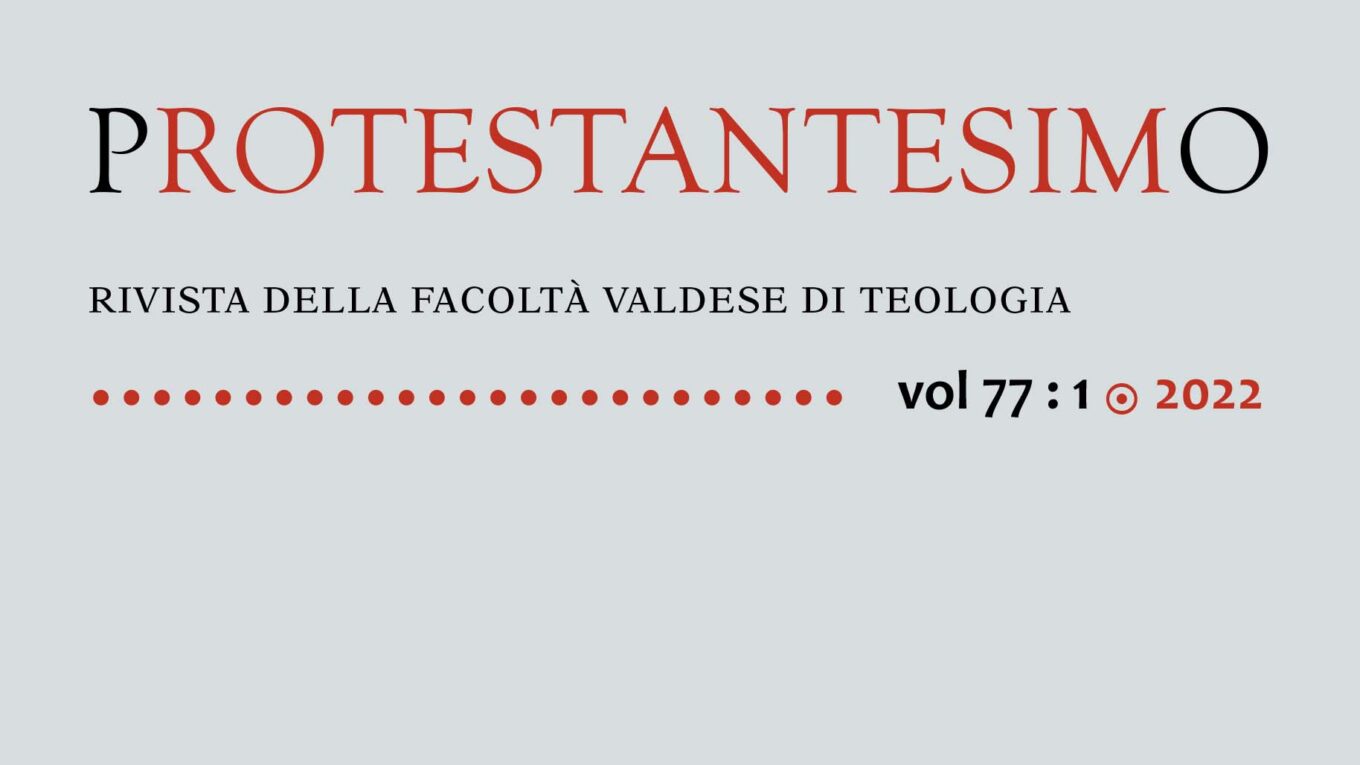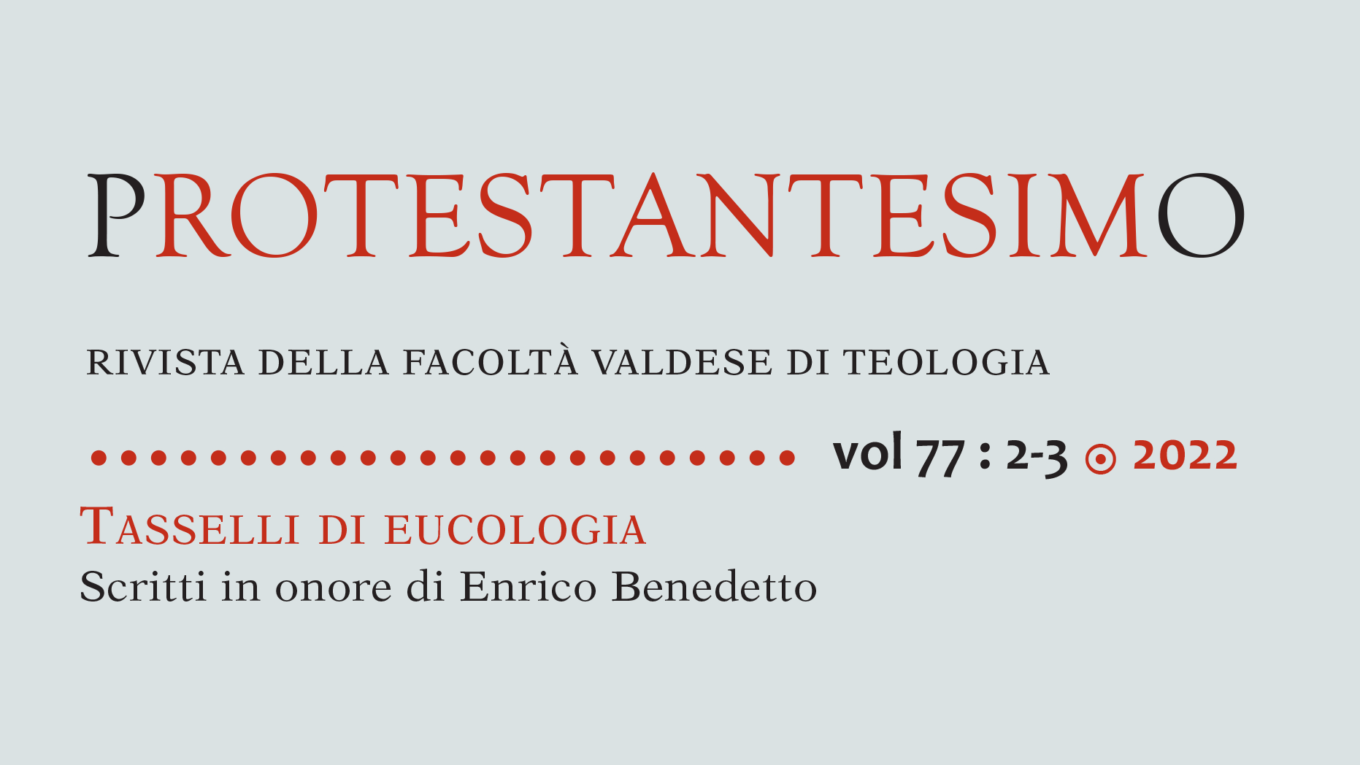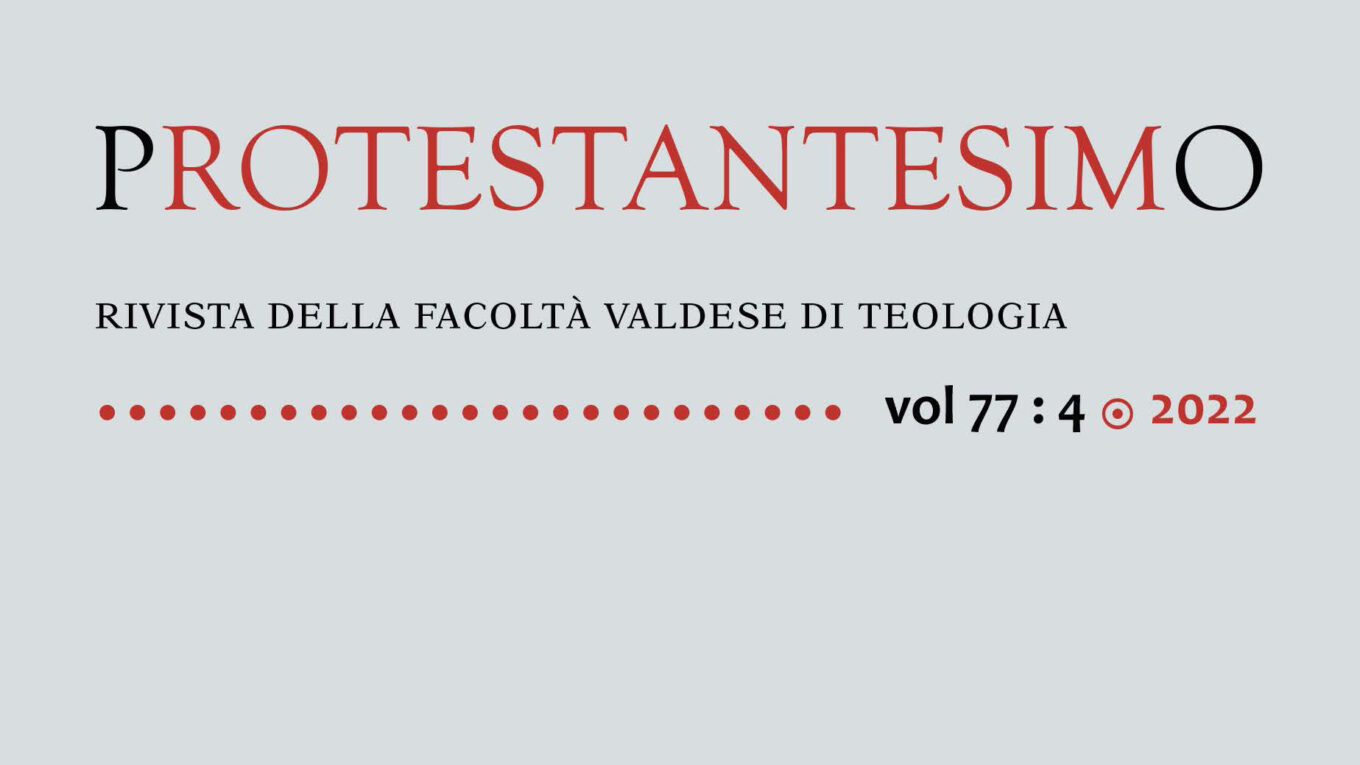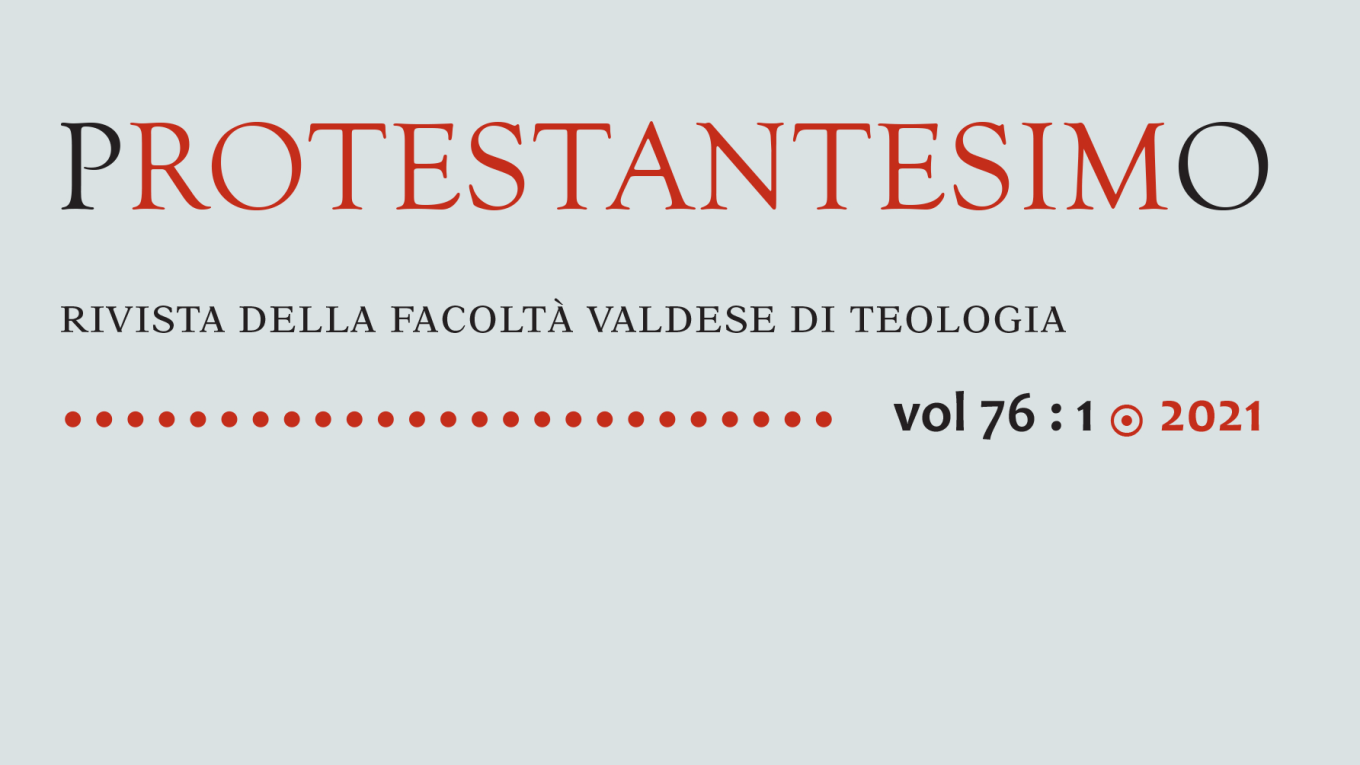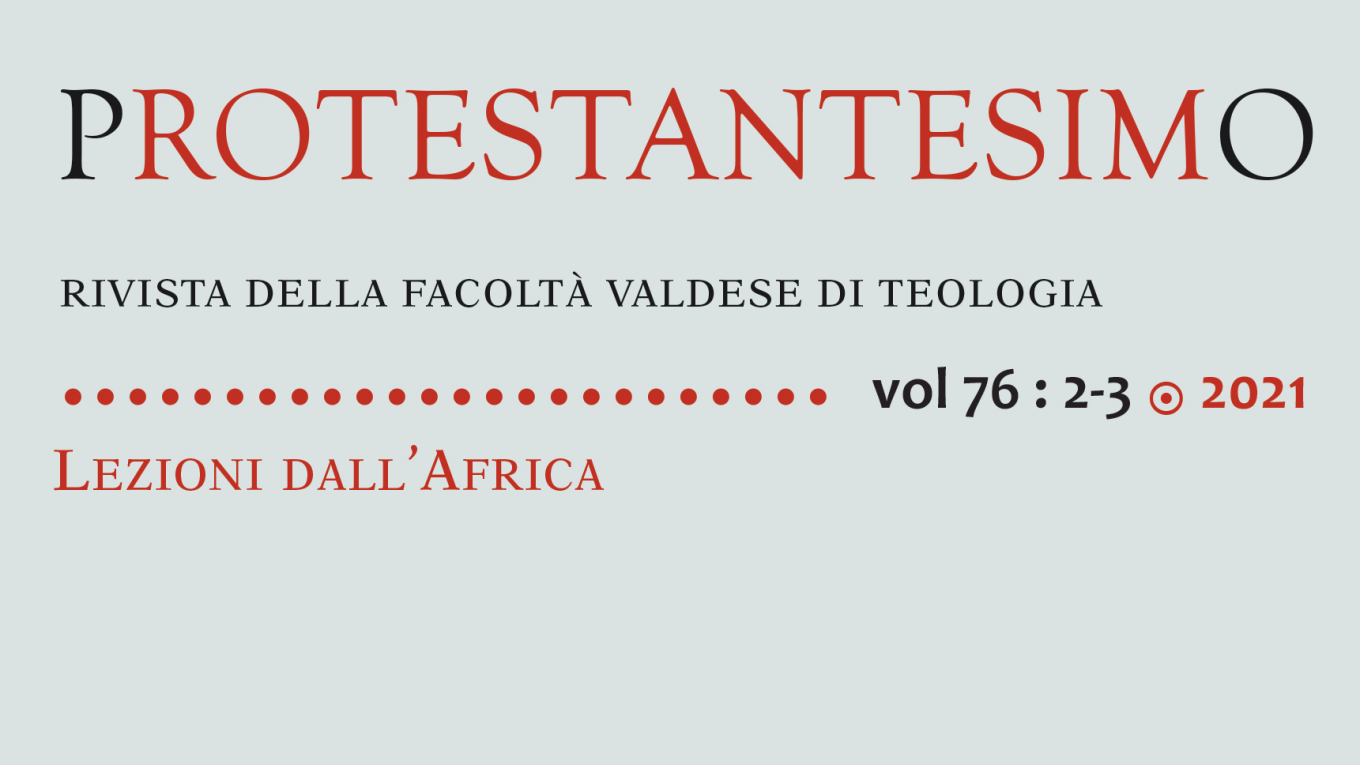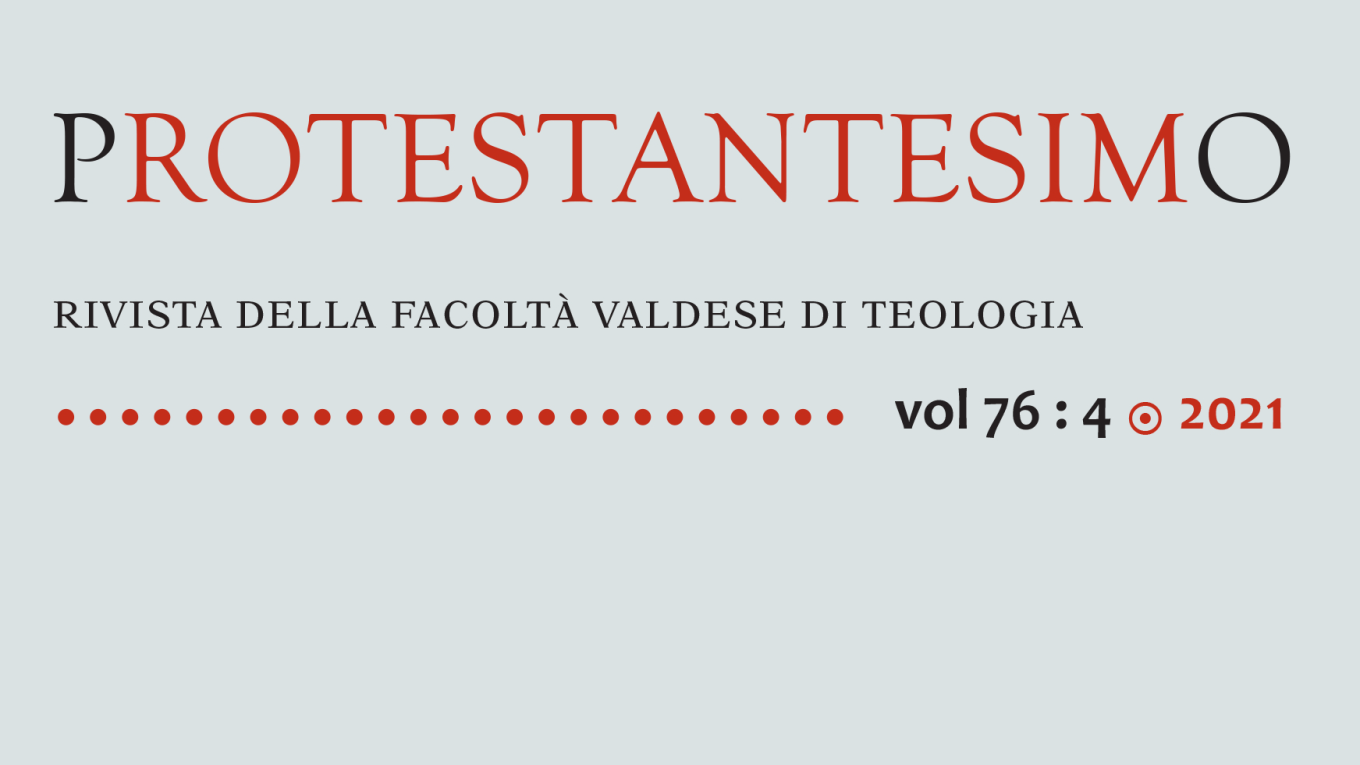Autore: wp_5978506
abstract vol 77 : 1
Oswald Bayer, L’ultima parola di Lutero: l’«Eneide divina»
Il biglietto scritto da Lutero due giorni prima della morte si compone come antitesi alla conclusione autocelebrativa della Tebaide del poeta romano Publio Papinio Stazio. In un climax ascendente sono evocati i tre ambiti della vita pri- vata, della politica e della chiesa e le esperienze da compiervi richiedono un lasso di tempo sempre crescente e la comprensione di testi esemplari, che nel caso della chiesa sono rappresentati dalla Scrittura. L’indicazione iperbolica secondo la quale la comprensione della Scrittura richiede cento anni di governo ecclesiastico assieme ai profeti segnala che questa dimensione della conoscenza umana costituisce una critica radicale a quelle precedenti. Praticandola, ci si rende conto di essere «mendicante».
Oswald Bayer, Luther’s Last Word: «The Divine Aeneid»
The short note written by Luther two days before his death is composed as an antithesis to the self-celebrating conclusion of the Thebais by the Roman poet Publius Papinius Statius. In a rising climax, the three fields – his private life, politics and the Church – are remembered. The experiences to be lived in these fields require an ever-increasing length of time and the comprehension of exemplary texts, which, in the case of the Church, are represented by the Scripture. The hyperbolic statement according to which the comprehension of the Scripture requires one hundred years of ecclesiastical government together with the Prophets, indicates that this dimension of human comprehension involves a radical critique of the preceding ones. When one puts it into practice, one finds oneself to be a “beggar.
Nicola Mariani, Ispirazione ed ermeneutica della Scrittura nel pensiero di Ulrich H.J. Körtner
Il vero senso della Scrittura si attualizza quale promessa di Dio ogni volta che il lettore ispirato viene costituito membro performativo della comunità interpretante dall’evento cristologico testimoniato dalla Scrittura. Autorità e ispirazione della Scrittura devono essere comprese entro il campo di tensione in cui figurano la pluralità delle interpretazioni concordi con il senso del testo, il materiale scritto della Bibbia, l’intenzione degli autori e la fede apostolica, che an- nuncia come possibilità futura quanto già comunicato nel kerygma. La comunicazione del senso della Scrittura non dipende da precomprensioni solidali con questa, ma è evento kenotico che accade in signo crucis.
Nicola Mariani, Inspiration and Hermeneutics of the Scripture in the Thought of Ulrich H.J. Körtner
The real sense of the Scripture becomes real as God’s promise in the present, every time that the inspired reader becomes a performative member of the Congregation, which interprets the Christological event as testified in the Scripture. Authority and inspiration of the Christological event must be understood within the field of the tension which includes the plurality of interpretations in accordance with the sense of the text, the material written in the Bible, the intention of the Authors, and Apostolic faith, which announces as a future possibility what has already been announced in the kerygma. The communication of the sense of the Scripture does not depend on pre-comprehensions in agreement with this, but it is a kenotic event, which happens in signo crucis.
Antonella Varcasia, Don Antonino Tagliarini. Un testimone del primo evangelismo italiano
Sullo sfondo della «grande» storia del Risorgimento l’articolo ricostruisce la«piccola» storia della conversione alla fede evangelica di un proprietario terriero nella Palermo del 1861: la costituzione della prima chiesa valdese in Sicilia tra opposizioni esterne, tensioni interne e rapporti con la massoneria; il ruolo di consigliere dei pastori Appia e Simpson Kay; la crisi con il Comitato di evangelizzazione e il passaggio alla chiesa metodista; il tentativo fallito di costituire una Chiesa libera; la vita privata e l’attività di inventore e fotografo. Un testimone del primo evangelismo italiano, paradigma della trasmissione dei valori evangelici alle generazioni future.
Antonella Varcasia, Don Antonino Tagliarini. A Witness of the First Italian Protestantism
Against the background of the “big” history of Risorgimento, this article tells the “small” history of the conversion to the Protestant faith of a land owner in Palermo in 1861: the creation of the first Waldensian church in Sicily among external opposition, internal tensions and the rapport with freemansonry; his role as a counsellor of the Ministers Appia and Simpson Kay; the crisis with the Committee for evangelization and passing to the Methodist Church; the failed attempt to create a Free Church; his private life and his activities as an inventor and a photographer. A witness of the first Italian Protestantism, a paradigm of how to hand out Protestant values to future generations.
abstract vol 77 : 4
Marco Fornerone, Con chiunque (non) è oggi qui con noi. Studio del patto a Moab (Deut. 28,69 – 29,14)
Con l’obiettivo di spiegare perché sia definito come un patto distinto da quello di Oreb e a chi sia rivolto, questo contributo situa le sequenze iniziali del patto in Moab di Deuteronomio 28,69 – 29,14 nella storia redazionale del Pentateuco e ne identifica la funzione nel contesto della sua forma finale. Viene inoltre esplorato il modo in cui ci si rivolge ai destinatari, cogliendone l’ambiguità, intesa sia come strumento retorico costruttivo, sia come gender bias distruttivo. Viene così chiarito in che misura questo patto possa essere descritto come inclusivo.
Marco Fornerone, With Whoever is (not) with Us Here, Today. A study on the Covenant in Moab (Deut. 28.69 – 29.14)
This article aims at explaining why this Covenant is considered different from that of Horeb and to whom it is addressed. This study places the opening sequences of the Covenant in Moab in Deuteronomy 28.69 – 29.14 in the history of the redaction of the Pentateuch and identifies its functions in the context of its final form. Moreover, it explores the way the audience is addressed, paying particular attention to its ambiguity, both as a constructive rhetorical device and a destructive gender bias, in order to understand in which sense this Covenant can be described as inclusive.
Sergio Rostagno, Teologia per l’Europa
Arrivando, dopo una introduzione al tema, alla discussione fatta da vari filosofi italiani sul concetto di «iato» posto quale elemento della metafisica, l’articolo sostiene che tale concetto si situa a metà quale momento del pensiero (lo- gos) tra una direzione trascendente e una direzione volta alla prassi dell’uomo. Il tema della incommensurabilità o dello iato in relazione alla verità, sostengono vari filosofi, sfocia nella relazione amicale tra vari approcci nell’ambito della finitezza umana. L’autore sostiene infine che ciò può valere anche nel rapporto tra religioni in Europa e ovunque.
Sergio Rostagno, Theology for Europe
Arriving, after an introduction to the subject, at the discussion made by various Italian philosophers of the concept of “hiatus” placed as an element of Metaphysics, the Article argues that this concept is located halfway as a moment of thought (logos) between a transcendent direction and a direction aimed at the praxis of man. The theme of incommensurability or hiatus in relation to truth, as argued by various philosophers, results in the amiable relationship between various approaches within the framework of human finiteness. Finally, the author argues that this can also be true of the relationship between religions in Europe and everywhere else.
Cesare G. De Michelis, Il «Grande Inquisitore»: filologia, esegesi e filosofia
Il «poema» di Ivan Karamazov, incentrato sull’incontro tra il Grande Inquisitore di Siviglia e lo Sconosciuto (che riconosce nel Cristo, tornato temporaneamente sulla terra) ha attratto l’attenzione dei commentatori dai più disparati punti di vista, innescando così un processo di lettura attualizzante del testo come «metafora assoluta»: dall’interesse per le questioni metafisiche e teologiche a quello per la natura del potere terreno della chiesa, e soprattutto a quello della «libertà». Con questo intervento s’intende porre al centro dell’esegesi l’interesse per la natura narratologica, culturale e storico-politica dell’episodio dei Fratelli Karamazov, che sfocia nei drammi etici e metafisici del suo tempo, senza farsi trascinare nell’ermeneutica del paratesto. Ciò ripropone il carattere di «menippea» del dialogo in questione, che ne comporta la natura di serio-comico rileva- bile da particolarità del testo spesso non rese in traduzione, venendo così a de- finire la struttura profonda della narrazione dostoevskiana.
Cesare G. De Michelis, The “Grand Inquisitor”: Philology Exegesis and Philosophy
The “poem” by Ivan Karamazov, centred on the encounter between the Grand Inquisitor of Seville and the Stranger (whom he recognizes as being Christ, temporarily returned to Earth) has attracted the attention of commentators holding the most different points of view. This has triggered a process of interpretation that has brought it up to date, considering it an “absolute metaphor”: from the interest in metaphysical and theological matters to the interest in the nature of power in the Church, especially “liberty”. This study aims at bringing to the cen- tre of exegesis of this episode of The Brothers Karamazov the interest in the sto- ry-telling, cultural and historical-political aspects. This leads to the ethical and metaphysical dramas of the time, without drawing us to a hermeneutics of the paratext. This suggests again the character of “a Menippean satire” of the dialogue in question, which implies the serious-comical nature that comes out of details in the text, which are often not rendered in translation, thus defining the profound structure of Dostoevsky’s narrative.
Fulvio Ferrario, Camus e Monod in dialogo
L’articolo esamina la visione del mondo «naturalistica» proposta, in un interessante esperimento narrativo, dal filosofo Telmo Pievani. Egli intreccia, in modo creativo, ma fedele alle fonti, riflessioni dello scrittore Albert Camus e del biologo Jacques Monod, entrambi premi Nobel e legati da amicizia. Nella maggior parte delle sue espressioni, compresa quella di Pievani, il naturalismo non ritiene che la teologia cristiana costituisca un’interlocutrice significativa. Per il pensiero credente, invece, la critica naturalistica costituisce una sfida ineludibile, che dovrebbe essere raccolta nell’ambito di una teologia della creazione sensibile alle istanze culturali del nostro tempo.
Fulvio Ferrario, Camus and Monod in Dialogue
This article examines the vision of the “naturalistic” world as proposed, in an interesting narrative experiment, by the philosopher Telmo Pievani. He intertwines, creatively but remaining faithful to the sources, reflections of the writer Albert Camus and the biologist Jacques Monod, both Nobel Prize winners and tied by friendship. In most of his statements, including Pievani’s, Naturalism does not consider Christian Theology as a significant interlocutor. On the other hand, for believers, naturalistic critique is an unavoidable challenge, which should be gathered into the sphere of a Theology of Creation that takes into account the cultural expectations of our time.
abstract vol 76 : 4
Fulvio Ferrario, La polpa e la buccia. Note su una struttura ermeneutica fondamentale della modernità
La distinzione tra il nucleo contenutistico di un dogma, di una dottrina, o della stessa fede cristiana in quanto tale, e la sua forma espressiva (polpa e buccia, per dirla in termini metaforici) ha sempre costituito una struttura fondamentale del pensiero teologico: nel Novecento, essa è stata tematizzata anche dal punto di vista metodologico e ha costituito, in ambito sia cattolico, sia pro- testante, uno degli assi centrali della riflessione ermeneutica. L’articolo approfondisce tale dialettica in riferimento al pensiero di Adolf von Harnack, Rudolf Bultmann e Dietrich Bonhoeffer, cercando di evidenziarne i limiti e i possibili rischi di semplificazione, ma anche il carattere inevitabile.
Fulvio Ferrario, The Pulp and the Peel. Notes on a Fundamental Hermeneutic Structure of Modernity
The distinction between the nucleus which emphasizes content rather than form in a dogma, a doctrine, or Christian faith itself, and its expressive form (the pulp and the peel, using a metaphor) has always been a fundamental structure of theological thought: in the 20th century, it became the theme also from a methodological point of view and became, both in the Catholic and the Protestant context, one of the central pivots of hermeneutics reflection. The article studies thoroughly these dialectics vis-à-vis the thought of Adolf von Harnack, Rudolf Bultmann and Dietrich Bonhoeffer, trying to highlight the limits and possible risks derived from simplification, but also its inevitable peculiarity.
Paolo Ricca, Valdo Vinay teologo
Un alunno ricorda il suo insegnante, un discepolo ricorda il suo maestro. Ricordi belli di un rapporto fecondo e costruttivo. È sempre difficile misurare la consistenza dell’impronta lasciata dal maestro sul discepolo, ma questa impronta c’è e viene riconosciuta, dopo decenni, come benefica. Non c’è bisogno di idealizzare il maestro, che è stato grande di suo. Chi è stato dunque Valdo Vinay? Sostanzialmente un teologo in ogni fibra del suo essere, in ogni momento della sua vita adulta e in ogni aspetto della sua poliedrica attività, che desta meraviglia per quantità e qualità: teologo come pastore (lo è stato per diversi anni, prima di essere nominato in Facoltà di teologia come docente), come storico (molto belle le sue numerose monografie), come decano della Facoltà (di cui ha rifondato la Biblioteca, unica nel suo genere in Italia), come evangelizzatore nel Basso Lazio, come ecumenista (nel SAE e a Sant’Egidio).
Paolo Ricca, Valdo Vinay the Theologian
A student remembers his teacher, a disciple remembers his master. Beauti- ful memories of a fruitful and constructive relationship. It is always difficult to measure the importance of the mark left by the master on the disciple, but this mark is there and is recognized, even decades later, as beneficial. It is not nec- essary to idealize the master, who was great of his own account. Who was Valdo Vinay, then? Basically a theologian in every fibre of his being, in every mo- ment of his adult life and in every aspect of his multi-faced activity: this makes one wonder because of its quantity and quality: as a theologian, as a minister (he was that for many years, before he was appointed as a lecturer at the Fac- ulty of Theology), as a dean of the Faculty (he re-founded the Library, which is the only one of its kind in Italy), as a bringer of the Word in Southern Lazio, and as an ecumenist (in the Secretariat of Ecumenical Activities and in the Sant’Egidio Community).
Mario Gnocchi, Io non mi vergogno dell’evangelo
L’articolo ripercorre il ruolo di Valdo Vinay nel Segretariato Attività Ecumeniche (SAE), fondato da Maria Vingiani nel secondo dopoguerra. In questo contesto, come negli altri campi delle sue attività, l’impegno di Vinay si contraddistinse per la concentrazione sul vangelo, anche nel senso di una distanza critica nei confronti dell’attivismo sociale e di un focus sulle istanze etiche. Nel richiamo alla irrinunciabile priorità del vangelo e del suo messaggio di salvezza rispetto a ogni sia pur nobile istanza etica e sociale, ricorrente in tutta la sua predicazione, è riconoscibile l’impronta del magistero di Karl Barth, che esercitò un profondo influsso su di lui come su gran parte dei teologi della sua generazione. La centralità cristologica dell’ispirazione e della testimonianza di Vi- nay si rifletteva anche nel suo deciso orientamento ecumenico.
Mario Gnocchi, I Am not Ashamed of the Gospel
The article goes over the role of Valdo Vinay in the Secretariat of Ecumenical Activities (SAE), founded by Maria Vingiani after the Second World War. In this context, as in the other fields of his activities, Vinay’s commitment was concentrated on the Gospel, also in the sense of a critical distance from social activism and a focus on ethical instances. In his referring to the indispensable priority of the Gospel and in his message of salvation rather than any noble ethical and social instance, which was a recurring feature in his preaching, it is possible to recognize the mark of the teaching of Karl Barth, who had a deep influence on him, as on most of the theologians of his generation. The Christo- logical centrality of Vinay’s inspiration and testimony was reflected also in his marked ecumenical orientation.
Yann Redalié, Paolo, un riformatore mancato?
I vari elementi messi a fuoco dalla critica dell’interpretazione riformata di Paolo possono integrarsi se si accetta il carattere contradditorio della teologia dell’apostolo e se si cerca di darne conto in modo significativo. È la sfida affrontata dagli autori nel loro studio della Lettera ai Romani, come testimonianza di Paolo Riformatore del Giudaismo, in nome di un Dio uno e unico che vuole salvare tutti gli umani, ma anche tutto l’uomo. Per integrare i vari aspetti del pensare paolino in un ritratto teologico pluridimensionale e convincente, che metta in luce sia la dimensione storico sociale: la visione di un’umanità nuova, al di là di ogni confine, sia la dimensione esistenziale, vengono proposte sei letture di tutta la lettera che prendono in considerazione sei punti di vista: il movimento del testo e lo sviluppo delle idee, il contesto storico (i conflitti nell’impero e nel cristianesimo nascente), il significato e le funzioni delle immagini presenti nella lettera. Centrale, in seguito, la lettura teologica delle quattro diverse concezioni della salvezza, con le quali Paolo si confronta. Completano la panoramica, una lettura storico-sociale e una lettura psicologica della lettera. La tesi, sostenuta attraverso questo percorso ricco e innovativo, è anche titolo del penultimo capitolo dell’opera, La Lettera ai Romani: le ragioni di un riformatore mancato.
Yann Redalié, Paul, an Unsuccessful Reformer?
The various elements focussed on by the criticism of Paul’s reformed interpretation, can integrate one another if we accept the contradictory features of the Apostle’s theology, and if we try to explain them in a significant way. This is the challenge faced by the authors who study the Epistle to the Romans, as a testimony of Paul as the Reformer of Judaism, in the name of the one and only God who wants to save all the human beings, but also the complete human being. In order to integrate the various aspects of Paul’s thought in a multidimensional and convincing theological portrait, which can highlight both the historical and social dimension: the vision of a new humanity, beyond any border, and the existential dimension, six suggestions of reading of the whole letter are offered, which take into account six different points of view: the movement of the text and the development of ideas, the historical context (the conflicts in the empire and in dawning Christianity), the meaning and the functions of images which are found in the letter. Later, the theological reading of the four different concepts of salvation, confronted by Paul. The overview is completed by a historical-social reading and a psychological reading of the letter. The thesis, support- ed by this rich and innovative route, is also the title of the penultimate chapter of the work: The Epistle to the Romans: the Reasons of an Unsuccessful Reformer.

